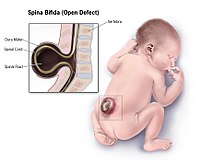
Photo from wikipedia
Introduction The facial nerve is the most vulnerable structure during otological surgeries. Facial canal dehiscence (FCD) is the main risk factor for iatrogenic injuries. Its prevalence in clinical studies ranges… Click to show full abstract
Introduction The facial nerve is the most vulnerable structure during otological surgeries. Facial canal dehiscence (FCD) is the main risk factor for iatrogenic injuries. Its prevalence in clinical studies ranges between 6 and 33.3%, while anatomical studies report 25–57%. The objective was to determine the prevalence of FCD stratified by age and gender in a healthy population. Materials and methods Temporal bones from high-resolution computed tomography (CT) were analyzed. Patients with a history of trauma or tumors of the temporal bone, cholesteatomas, chronic middle ear disease, and any pathology that could modify the bone’s anatomy, were excluded. Results A total of 184 temporal bones were included. FCD was observed in 94 (51.2%) of the analyzed bones. The tympanic portion was the most frequently affected site with 91 (49.5%), followed by the mastoid segment with 3 (1.6%). No dehiscence was found in the labyrinth portion. We observed 30 (31.9%) of the FCD involved the oval window. Other bone defects identified with the FCD included: 11 (11.7%) with a lateral semicircular canal fistula and 7 (7.4%) with tegmen tympani erosions. Conclusion FCD has a high prevalence among healthy patients. A pre-surgical otological evaluation using high-resolution CT should be indicated to properly assess the patient and reduce the risk of injury.
Journal Title: European Archives of Oto-Rhino-Laryngology
Year Published: 2020
Link to full text (if available)
Share on Social Media: Sign Up to like & get
recommendations!